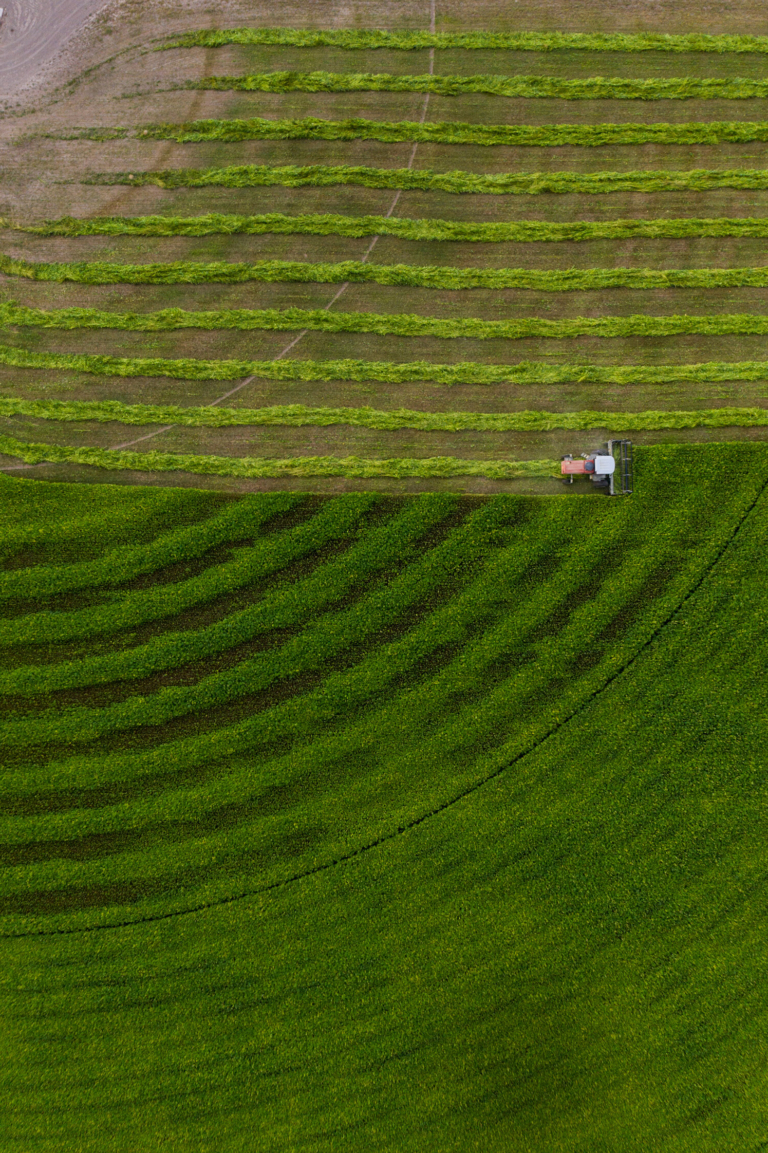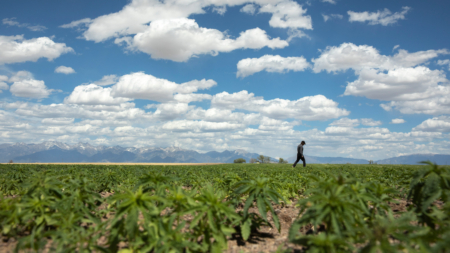Bring Hemp Home: Colorado
In Colorado’s San Luis Valley, two farmers are growing industrial hemp to improve their topsoil—and their bottom line—as they face worsening drought.
Six years ago, in Colorado’s San Luis Valley, potato and barley farmer Shanan Wright and his son-in-law Dion Oakes almost gave up on growing industrial hemp. By mandate of the Colorado Department of Agriculture, Cannabis sativa L. must test below .3 percent THC on a dry-weight basis to be considered legal. “We were testing at .31 percent,” Oakes recalls. “They had no lenience. We had to destroy 180 acres right there, burn it in the field, video it and send it them, and that was it.”
“The money loss was a big part of it,” Wright says. “But as a farmer, something that you work on day and night—something you work really hard at and then you have to sit there and watch it burn—that’s a tough thing to swallow.”
Wright and Oakes decided that day that growing industrial hemp was too risky for their bottom line. But then, any kind of farming in the San Luis Valley was becoming increasingly risky—even the world’s largest alpine valley is not immune from the drought plaguing the American West. Add rising land and equipment costs to the equation, and it’s easy to see why Wright and Oakes decided to take a chance on hemp in the first place. Hemp’s low-water usage and ability to restore exhausted topsoil to health seemed like a pathway to their shared dream of staying on the land and leaving a viable farm to their kids and grandkids.
“I want a generational farm that can be passed down to my family, something to look at and really be proud of when they grow up,” Oakes says.

From Left to Right: Shanan Wright’s greatest wish is to leave a prospering farm for his kids and grandkids. Photo: Andrew Burr. Industrial hemp can help restore soil that’s been depleted by industrial ag practices. Photo: Cory Richards. Three reasons to work for a farmable future. Photo: Andrew Burr
Soon after the day they were forced to burn their hemp crop (which they had been growing for CBD), a fellow farmer encouraged them to give it another shot, but this time to grow hemp that can be used to make textiles and building materials. He pointed out that, due to the CBD craze that erupted immediately after passage of the Farm Bill, prices were already tanking. The real future of hemp—a future that can create sustainable market value and allows farmers to switch from input-heavy crops like cotton, corn and soy—lies in textiles.
They decided to give it another try. In early 2020, Patagonia Workwear connected Wright and Oakes with Colorado State University soil scientists, the governor of Colorado and Hongliang Ding, president of Hemp Fortex, our hemp supplier in China. The plan was to bring these folks together on the Wright-Oakes Farm to plant 319 acres of industrial hemp (60 of them organic), conduct research and share expertise. Then the COVID-19 pandemic hit.
As the world hunkered down, Wright and Oakes carried on with the project. Governor Polis and the CSU soil scientists participated, too, though in a socially distant capacity. Ding consulted from China via a series of video conference calls, sharing centuries of Chinese hemp cultivation knowledge upon which his business is built. From seed spacing and depth to noting weather patterns, everything was documented, tested and analyzed—the kind of research that generally hasn’t been conducted with hemp on US soil for over 80 years.

From Left to Right: Like all hemp seeds, the “Jin Ma” cultivar originated in central Asia. This cultivar has produced successful harvests in Kentucky and other parts of the US. Photo: Andrew Burr. San Luis Valley farmers can look to industrial hemp’s long center taproot to help restore topsoil by keeping it in place and pulling nutrients up from deep underground. Photo: Andrew Burr. Dion Oakes uses a density tester on his farm. Photo: Andrew Burr
Between May 14–27, 2020, Wright and Oakes planted a cultivar called “Jin Ma,” which originated in China. They seeded three test plots at 50, 75 and 100 pounds an acre, adjusted to germination rate and seed purity. By mid-July, the plots averaged 617,000 plants an acre, which is well below the 1.3 to 1.5 million plants an acre recommended for fiber production. In late August, the hemp was harvested and left on the ground for several weeks to undergo retting (a process that lets moisture and bacteria naturally break down the “glue” that binds the fibers). San Luis Valley-based Formation Ag, an emerging leader in engineering hemp-specific farm solutions, provided the harvesting and decortication equipment. Today, close to 1,000 bales of hemp from this harvest are stored on the Wright-Oakes Farm awaiting test results that will determine if it will be viable for textile production or as a building material.
The experiment seems to have presented more questions than answers. Abdel Berrada, PhD, agronomist and research scholar emeritus at Colorado State University, noted a few possible reasons why Jin Ma did not thrive in Colorado to the extent that it has in Kentucky. “Either the cultivar Jin Ma is not well adapted to the San Luis Valley,” he explained, “or its production was not optimized due to factors such as seeding date and rate, water management, cutting height and method, and retting.” Berrada also pointed out that heavy rain and hailstorms in late July caused ponding in large areas of one of the fields. Due to this saturation, “some of the nitrogen may have leached out below the root zone … [which might explain] the stunting and yellowing of the hemp plants.”
Today, Wright and Oakes remain in a state of “hurry up and wait”—both for fiber-testing results from Ding and for more farming technique guidance from CSU’s soil scientists. They are cautious, hopeful and aware that they’re not yet out of the woods. “If somebody comes up to you and says they know everything in hemp right now, be scared,” says Corbett Hefner, vice president of R&D at Formation Ag. “Because, boy, we learn every single day in this business. We keep identifying bottlenecks, and we solve those with technology, horsepower and equipment. Because we want farmers to make money.”

From Left to Right: The San Luis Valley hemp crop reached heights of 6 feet, which is on the short side for this cultivar. Photo: Cory Richards. Formation Ag’s FiberTrack decorticators separate the woody hurd from the fiber and accept whole and unsorted stalks, including baled material. Photo: Cory Richards. Summer storms in the San Luis Valley created ponding in some of the fields, which might have washed nitrogen out of the soil—a possible cause of the stunting and yellowing of the plants. Photo: Cory Richards
Ean Seeb, the Colorado governor’s special advisor on cannabis, echoes Hefner’s optimism. “This will be the cotton of this century, minus all the negative connotations,” he says. “This new crop will be something that created economic prosperity for Colorado’s farmers—and in the crazy state of the world and the middle of a pandemic. It’s nice to have that positivity in a world like today.”
We’re eagerly awaiting Ding’s advice about whether this crop meets fiber standards that will allow us to use it in our Workwear styles by 2023. There’s still a lot to learn, but we’re in this partnership for the long haul and grateful to everyone involved in the good, hard work of bringing hemp home.

For industrial hemp to work, it has to work for everyone—starting with the farmers. Photo: Cory Richards

